What to do if there is a lack of water flow in my York YT Millennium Chiller?
- CCindy KlineAug 3, 2025
If your York Chiller experiences a lack of water flow, check the operation of the chilled water pump.
What to do if there is a lack of water flow in my York YT Millennium Chiller?
If your York Chiller experiences a lack of water flow, check the operation of the chilled water pump.
What happens if the system load is less than minimum capacity in my York Chiller?
If the system load is less than the minimum capacity, the York Chiller will automatically restart when the water reaches the setpoint.
Crucial safety information to review before operating the equipment.
Outlines essential safety practices and hazard recognition for personnel.
Explains the meaning of symbols used to indicate hazards and important information.
Information subject to change without notice by the manufacturer.
Details technical changes made to the document in previous revisions.
Explains how the model number denotes unit characteristics and features.
Overview of the chiller system and its basic operating principles.
Detailed explanation of how the chiller functions during operation.
Explains how the chiller adjusts capacity using prerotation vanes for load variation.
Provides an overview of the OptiView Control Center's features and interface.
Lists functions controllable remotely via EMS or ISN networks.
Explains alpha-numeric codes representing software versions and components.
Describes the display, keypad, soft keys, and start/stop switch.
Explains how screens are presented and elements categorized.
Describes read-only parameters shown on the chiller display screens.
Details values and commands available for user modification via access levels.
Explains manual control functions and system screen navigation methods.
Describes screen display language selection options available to the user.
Provides tables of valid display ranges for various analog input values.
Provides a general description of the Home Screen display.
Lists parameters displayed on the Home Screen that cannot be changed.
Details parameters on the Home Screen that can be modified by the user.
Explains Login, Logout, Print, Message Clear, Warning Reset, and Navigation functions.
Details the purpose and content of the System Screen.
Lists parameters displayed on the System Screen without modification options.
Explains Current Limit, programmable settings, and navigation within the System Screen.
Explains the cutaway view and purpose of the Evaporator Screen.
Lists parameters displayed on the Evaporator Screen without modification options.
Covers programmable settings and navigation for the Evaporator Screen.
Explains the cutaway view and function of the Condenser Screen.
Lists parameters displayed on the Condenser Screen without modification options.
Covers programmable settings and navigation within the Condenser Screen.
Explains the cutaway view of the Purge Tank and its displayed elements.
Lists parameters shown on the Purge Screen that cannot be altered.
Details programmable settings and navigation for the Purge Screen.
Explains the cutaway view of the condenser and refrigerant level sensor.
Lists parameters shown on the Refrigerant Level Control Screen.
Covers programmable settings and navigation for refrigerant level control.
Explains the cutaway view of the compressor and its associated controls.
Lists parameters displayed on the Compressor Screen without modification options.
Details programmable settings and navigation for compressor controls like vanes and VSD.
Explains the cutaway view of the Hot Gas Bypass Valve and its parameters.
Lists parameters displayed on the Hot Gas Bypass Screen.
Details programmable settings and navigation for the Hot Gas Bypass control.
Explains the cutaway view of the compressor and surge protection parameters.
Lists parameters displayed on the Surge Protection Screen.
Details programmable settings and navigation for surge protection features.
Covers Surge Sensitivity, Clear Surge Count, and Navigation options.
Explains the screen used for calibrating pre-rotation vanes.
Lists parameters shown during vane calibration.
Details programmable options and navigation for vane calibration.
Explains the screen used for tuning the Variable Speed Drive.
Lists parameters displayed on the VSD Tuning Screen.
Details programmable settings and navigation for VSD tuning.
Explains the close-up view of the chiller oil sump.
Lists parameters displayed on the Oil Sump Screen.
Details programmable settings and navigation for manual oil pump operation.
Explains the screen displaying information for the Mod "A" Solid State Starter.
Lists parameters displayed on the Mod "A" SSS Screen.
Details programmable settings and navigation for the Mod "A" Solid State Starter.
Explains the screen displaying information for the Mod "B" Solid State Starter.
Lists parameters displayed on the Mod "B" SSS Screen.
Details programmable settings and navigation for the Mod "B" Solid State Starter.
Explains the screen displaying information for the Variable Speed Drive.
Lists parameters displayed on the VSD Screen.
Details programmable settings and navigation for the Variable Speed Drive.
Explains the screen displaying more detailed information on the VSD.
Lists detailed parameters displayed on the VSD Details Screen.
Details programmable settings and navigation for the VSD Details Screen.
Explains the screen displaying more detailed information on the ACC.
Lists parameters displayed on the ACC Details Screen.
Details programmable settings and navigation for the ACC Details Screen.
Explains the screen displaying more detailed information on the Harmonic Filter.
Lists parameters displayed on the Harmonic Filter Details Screen.
Details programmable settings and navigation for the Harmonic Filter.
Explains the screen for programming common setpoints.
Lists parameters displayed on the Setpoints Screen.
Details programmable settings and navigation for chiller setpoints.
Explains the screen for general chiller configuration.
Lists configuration parameters displayed on the Setup Screen.
Details programmable settings and navigation for system setup and configuration.
Configure communications, printer settings, and view sales order information.
View operating parameters and configure user preferences and access levels.
Explains the screen containing programmable schedule values.
Lists parameters displayed on the Schedule Screen.
Details programmable settings and navigation for the chiller's schedule.
Explains the screen for defining custom user IDs and passwords.
Lists parameters displayed on the User Screen.
Details programmable settings for user preferences and access levels.
Explains the screen for defining communications parameters.
Details settings for printer and COM 2 communication parameters.
Explains the screen for defining printer communications parameters.
Lists parameters displayed on the Printer Screen.
Details navigation options from the Printer Screen.
Explains the screen for defining sales order parameters.
Lists parameters displayed on the Sales Order Screen.
Details programmable settings for sales order parameters.
Explains the screen for defining general chiller operating parameters.
Lists parameters displayed on the Operations Screen.
Details programmable settings for chiller operation.
Explains the screen for browsing system faults.
Lists details of the last normal and fault shutdowns.
Covers programmable options and navigation for viewing historical data.
Explains viewing system parameters at the time of shutdown.
Lists the on-screen printout of system parameters.
Details programmable options and navigation for history details.
Explains the screen listing setpoint changes.
Lists the category, setpoint, and new value of changes.
Details programmable options and navigation for the security log.
Explains viewing details of logged setpoint changes.
Lists description, time, date, access level, user ID, old/new values.
Details programmable options and navigation for security log details.
Explains the X/Y graph format for trending selected parameters.
Lists parameters for graphical trending.
Details programmable options and navigation for trend display.
Explains configuring the trending screen parameters.
Lists parameters for trending configuration.
Details programmable settings and navigation for trend setup.
Explains setting up start/stop triggers for data collection.
Lists parameters displayed on the Advanced Trend Setup Screen.
Details programmable settings and navigation for advanced trend setup.
Explains the screen displaying slot numbers for trending.
Lists slot numbers of commonly monitored parameters.
Explains displaying selected parameters for troubleshooting.
Lists parameters displayed on the Custom View Screen.
Details programmable settings and navigation for custom view.
Explains selecting parameters for the Custom View Screen.
Lists available parameters for display selection.
Details programmable settings and navigation for custom view setup.
Lists messages indicating chiller state and running conditions.
Lists messages preventing startup and general warnings.
Lists routine, cycling, safety shutdowns, and specific fault messages.
Lists shutdown messages for LCSSS, VSD, and Harmonic Filters.
Information on oil heater operation and checking oil level in the reservoir.
Steps to follow for preparing and starting the chiller.
Explains chiller operation, vane control, and capacity adjustments.
Discusses condenser water temperature requirements for optimal chiller performance.
Lists conditions to periodically check during chiller operation.
Describes the importance of keeping a daily record of operating conditions.
Lists inspections for daily, weekly, and quarterly maintenance schedules.
Lists maintenance tasks for semi-annual and annual service intervals.
Explains why keeping the system free of moisture and gases is important.
Discusses automatic shutdowns for system protection.
Outlines the procedure for manually stopping the chiller.
Details the procedure for shutting down the chiller for extended periods.
Outlines the procedure for restarting the chiller after a long shutdown.
Describes the casing, compressor, bearings, internal gears, and lubrication system.
Details capacity reduction, shaft seal, open motor, and motor terminal box features.
Explains the oil pump, oil heater, shells, tubes, and water boxes of the lubrication system.
Describes cooler, condenser, refrigerant flow control, bursting disc, starters, and VSD.
Explains the function of the oil return system.
Provides steps for replacing the dehydrator.
Details the specific steps for charging the oil reservoir.
Lists causes of system shutdowns based on control center display.
Analyzes operating symptoms, potential causes, and remedies for chiller issues.
Information on obtaining replacement parts.
Procedures for testing the system for leaks and pressure.
Lists system pressures corresponding to vacuum levels for evacuation.
Procedures for vacuum testing and dehydrating the refrigeration system.
Explains the operation of the dehydration process using vacuum.
Procedures for charging the system with refrigerant, including vapor and liquid handling.
Lists refrigerant charge amounts for different chiller configurations.
Procedures for checking refrigerant charge during shutdown.
Steps for handling refrigerant during system repairs.
Procedure for testing motor insulation resistance.
Covers general maintenance, water treatment, and tube cleaning considerations.
Details cleaning procedures for cooler and condenser tubes, and fouling types.
Methods for cleaning cooler and condenser tubes.
Procedures for detecting tube leaks.
Details maintenance tasks for the compressor assembly.
Specific procedures for the compressor oil filter and annual pressure testing.
Maintenance for cooler, condenser, and purge unit based on intervals.
Maintenance for oil return system and inspection of electrical controls.
Crucial safety information to review before operating the equipment.
Outlines essential safety practices and hazard recognition for personnel.
Explains the meaning of symbols used to indicate hazards and important information.
Information subject to change without notice by the manufacturer.
Details technical changes made to the document in previous revisions.
Explains how the model number denotes unit characteristics and features.
Overview of the chiller system and its basic operating principles.
Detailed explanation of how the chiller functions during operation.
Explains how the chiller adjusts capacity using prerotation vanes for load variation.
Provides an overview of the OptiView Control Center's features and interface.
Lists functions controllable remotely via EMS or ISN networks.
Explains alpha-numeric codes representing software versions and components.
Describes the display, keypad, soft keys, and start/stop switch.
Explains how screens are presented and elements categorized.
Describes read-only parameters shown on the chiller display screens.
Details values and commands available for user modification via access levels.
Explains manual control functions and system screen navigation methods.
Describes screen display language selection options available to the user.
Provides tables of valid display ranges for various analog input values.
Provides a general description of the Home Screen display.
Lists parameters displayed on the Home Screen that cannot be changed.
Details parameters on the Home Screen that can be modified by the user.
Explains Login, Logout, Print, Message Clear, Warning Reset, and Navigation functions.
Details the purpose and content of the System Screen.
Lists parameters displayed on the System Screen without modification options.
Explains Current Limit, programmable settings, and navigation within the System Screen.
Explains the cutaway view and purpose of the Evaporator Screen.
Lists parameters displayed on the Evaporator Screen without modification options.
Covers programmable settings and navigation for the Evaporator Screen.
Explains the cutaway view and function of the Condenser Screen.
Lists parameters displayed on the Condenser Screen without modification options.
Covers programmable settings and navigation within the Condenser Screen.
Explains the cutaway view of the Purge Tank and its displayed elements.
Lists parameters shown on the Purge Screen that cannot be altered.
Details programmable settings and navigation for the Purge Screen.
Explains the cutaway view of the condenser and refrigerant level sensor.
Lists parameters shown on the Refrigerant Level Control Screen.
Covers programmable settings and navigation for refrigerant level control.
Explains the cutaway view of the compressor and its associated controls.
Lists parameters displayed on the Compressor Screen without modification options.
Details programmable settings and navigation for compressor controls like vanes and VSD.
Explains the cutaway view of the Hot Gas Bypass Valve and its parameters.
Lists parameters displayed on the Hot Gas Bypass Screen.
Details programmable settings and navigation for the Hot Gas Bypass control.
Explains the cutaway view of the compressor and surge protection parameters.
Lists parameters displayed on the Surge Protection Screen.
Details programmable settings and navigation for surge protection features.
Covers Surge Sensitivity, Clear Surge Count, and Navigation options.
Explains the screen used for calibrating pre-rotation vanes.
Lists parameters shown during vane calibration.
Details programmable options and navigation for vane calibration.
Explains the screen used for tuning the Variable Speed Drive.
Lists parameters displayed on the VSD Tuning Screen.
Details programmable settings and navigation for VSD tuning.
Explains the close-up view of the chiller oil sump.
Lists parameters displayed on the Oil Sump Screen.
Details programmable settings and navigation for manual oil pump operation.
Explains the screen displaying information for the Mod "A" Solid State Starter.
Lists parameters displayed on the Mod "A" SSS Screen.
Details programmable settings and navigation for the Mod "A" Solid State Starter.
Explains the screen displaying information for the Mod "B" Solid State Starter.
Lists parameters displayed on the Mod "B" SSS Screen.
Details programmable settings and navigation for the Mod "B" Solid State Starter.
Explains the screen displaying information for the Variable Speed Drive.
Lists parameters displayed on the VSD Screen.
Details programmable settings and navigation for the Variable Speed Drive.
Explains the screen displaying more detailed information on the VSD.
Lists detailed parameters displayed on the VSD Details Screen.
Details programmable settings and navigation for the VSD Details Screen.
Explains the screen displaying more detailed information on the ACC.
Lists parameters displayed on the ACC Details Screen.
Details programmable settings and navigation for the ACC Details Screen.
Explains the screen displaying more detailed information on the Harmonic Filter.
Lists parameters displayed on the Harmonic Filter Details Screen.
Details programmable settings and navigation for the Harmonic Filter.
Explains the screen for programming common setpoints.
Lists parameters displayed on the Setpoints Screen.
Details programmable settings and navigation for chiller setpoints.
Explains the screen for general chiller configuration.
Lists configuration parameters displayed on the Setup Screen.
Details programmable settings and navigation for system setup and configuration.
Configure communications, printer settings, and view sales order information.
View operating parameters and configure user preferences and access levels.
Explains the screen containing programmable schedule values.
Lists parameters displayed on the Schedule Screen.
Details programmable settings and navigation for the chiller's schedule.
Explains the screen for defining custom user IDs and passwords.
Lists parameters displayed on the User Screen.
Details programmable settings for user preferences and access levels.
Explains the screen for defining communications parameters.
Details settings for printer and COM 2 communication parameters.
Explains the screen for defining printer communications parameters.
Lists parameters displayed on the Printer Screen.
Details navigation options from the Printer Screen.
Explains the screen for defining sales order parameters.
Lists parameters displayed on the Sales Order Screen.
Details programmable settings for sales order parameters.
Explains the screen for defining general chiller operating parameters.
Lists parameters displayed on the Operations Screen.
Details programmable settings for chiller operation.
Explains the screen for browsing system faults.
Lists details of the last normal and fault shutdowns.
Covers programmable options and navigation for viewing historical data.
Explains viewing system parameters at the time of shutdown.
Lists the on-screen printout of system parameters.
Details programmable options and navigation for history details.
Explains the screen listing setpoint changes.
Lists the category, setpoint, and new value of changes.
Details programmable options and navigation for the security log.
Explains viewing details of logged setpoint changes.
Lists description, time, date, access level, user ID, old/new values.
Details programmable options and navigation for security log details.
Explains the X/Y graph format for trending selected parameters.
Lists parameters for graphical trending.
Details programmable options and navigation for trend display.
Explains configuring the trending screen parameters.
Lists parameters for trending configuration.
Details programmable settings and navigation for trend setup.
Explains setting up start/stop triggers for data collection.
Lists parameters displayed on the Advanced Trend Setup Screen.
Details programmable settings and navigation for advanced trend setup.
Explains the screen displaying slot numbers for trending.
Lists slot numbers of commonly monitored parameters.
Explains displaying selected parameters for troubleshooting.
Lists parameters displayed on the Custom View Screen.
Details programmable settings and navigation for custom view.
Explains selecting parameters for the Custom View Screen.
Lists available parameters for display selection.
Details programmable settings and navigation for custom view setup.
Lists messages indicating chiller state and running conditions.
Lists messages preventing startup and general warnings.
Lists routine, cycling, safety shutdowns, and specific fault messages.
Lists shutdown messages for LCSSS, VSD, and Harmonic Filters.
Information on oil heater operation and checking oil level in the reservoir.
Steps to follow for preparing and starting the chiller.
Explains chiller operation, vane control, and capacity adjustments.
Discusses condenser water temperature requirements for optimal chiller performance.
Lists conditions to periodically check during chiller operation.
Describes the importance of keeping a daily record of operating conditions.
Lists inspections for daily, weekly, and quarterly maintenance schedules.
Lists maintenance tasks for semi-annual and annual service intervals.
Explains why keeping the system free of moisture and gases is important.
Discusses automatic shutdowns for system protection.
Outlines the procedure for manually stopping the chiller.
Details the procedure for shutting down the chiller for extended periods.
Outlines the procedure for restarting the chiller after a long shutdown.
Describes the casing, compressor, bearings, internal gears, and lubrication system.
Details capacity reduction, shaft seal, open motor, and motor terminal box features.
Explains the oil pump, oil heater, shells, tubes, and water boxes of the lubrication system.
Describes cooler, condenser, refrigerant flow control, bursting disc, starters, and VSD.
Explains the function of the oil return system.
Provides steps for replacing the dehydrator.
Details the specific steps for charging the oil reservoir.
Lists causes of system shutdowns based on control center display.
Analyzes operating symptoms, potential causes, and remedies for chiller issues.
Information on obtaining replacement parts.
Procedures for testing the system for leaks and pressure.
Lists system pressures corresponding to vacuum levels for evacuation.
Procedures for vacuum testing and dehydrating the refrigeration system.
Explains the operation of the dehydration process using vacuum.
Procedures for charging the system with refrigerant, including vapor and liquid handling.
Lists refrigerant charge amounts for different chiller configurations.
Procedures for checking refrigerant charge during shutdown.
Steps for handling refrigerant during system repairs.
Procedure for testing motor insulation resistance.
Covers general maintenance, water treatment, and tube cleaning considerations.
Details cleaning procedures for cooler and condenser tubes, and fouling types.
Methods for cleaning cooler and condenser tubes.
Procedures for detecting tube leaks.
Details maintenance tasks for the compressor assembly.
Specific procedures for the compressor oil filter and annual pressure testing.
Maintenance for cooler, condenser, and purge unit based on intervals.
Maintenance for oil return system and inspection of electrical controls.
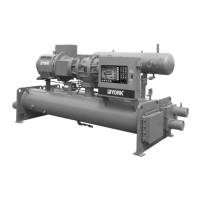
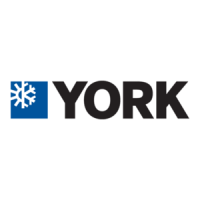
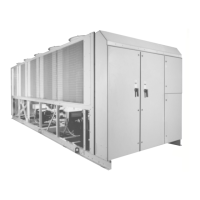




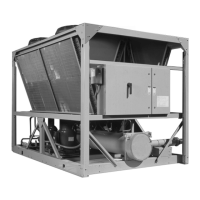

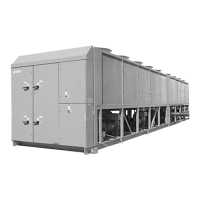
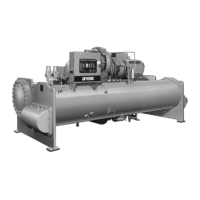

